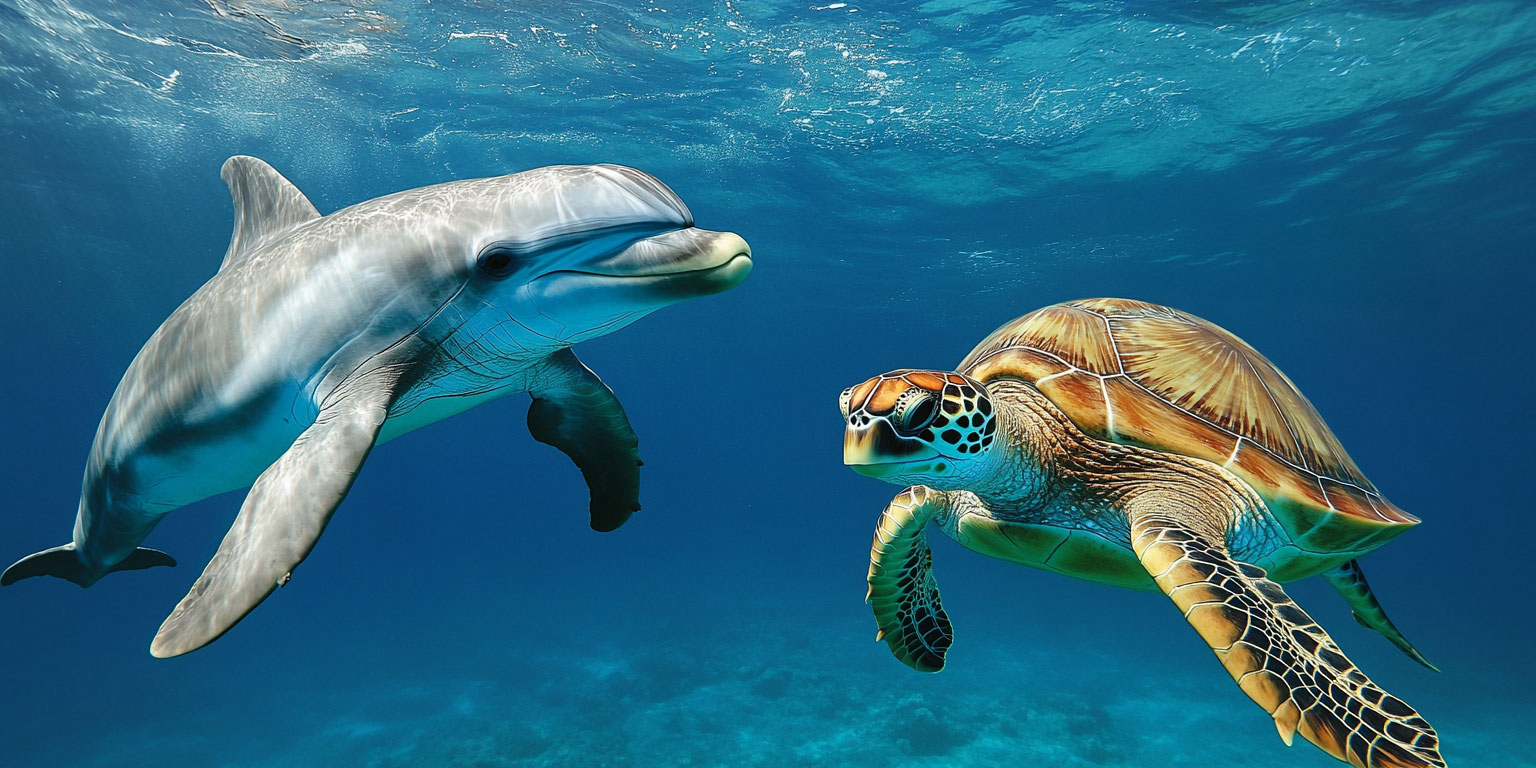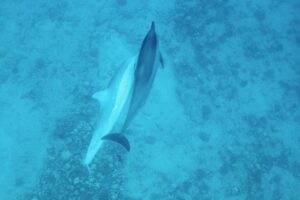On the coastlines of Oʻahu, you’ll often spot dolphins and sea turtles moving through the same waters. It’s not a coincidence. These two marine species share the same nearshore habitat, breathe air at the surface, and hunt for food in overlapping areas. Their co-existence is natural, not planned, and it makes for one of the best wildlife experiences you can have on a Hawaiian tour.
This post will walk you through why dolphins and sea turtles are so often seen together, when to catch them, what they eat, and what it all means for tour-goers.
1. Shared Habitat: Why the Same Place?
Dolphins and turtles both live in nearshore waters, the area stretching from the shoreline out to about 150 feet deep. These coastal zones are warm, rich with life, and shallow enough for both animals to find food and air easily.
What makes this area ideal?
- Sunlight helps coral, sea grass, and sponges thrive.
- Reefs support turtles that feed on sponges and algae.
- Dolphins chase fish, squid, and other prey near the reef edges.
- Both species can surface easily to breathe.
The habitat gives them everything they need, so it’s no wonder they show up in the same waters so often. If you’re on a tour boat along Oʻahu’s coast, there’s a good chance you’ll catch sight of both.
2. Air Breathers: Dolphins and Turtles at the Surface
Unlike fish, dolphins and turtles can’t get oxygen from water. They both breathe air, which means they need regular access to the surface.
- Dolphins come up every few minutes. They are constantly diving and surfacing.
- Sea turtles can hold their breath for much longer but still need to surface, especially when they’re resting or warming in the sun.
This shared need puts them in the same areas where surfacing is safe and easy. Close to the coast, in calmer waters, it’s easier for both to rise without stress. These moments are often when tourists get a perfect view from the boat or during a snorkel stop.
3. Food Sources: Different Diets, Same Restaurant
Although their diets are very different, both dolphins and turtles depend on biodiverse feeding zones, often located around coral reefs and grass beds.
- Dolphins eat:
- Small fish
- Squid
- Crustaceans
- Sea turtles, especially Hawksbills, eat:
- Sponges
- Algae
- Occasionally jellyfish and soft corals
Even though they aren’t competing for the same food, they both visit the same “underwater restaurants” where these resources grow. The result? They end up in the same spots, swimming through the same paths, day after day.
4. Do Dolphins and Sea Turtles Interact?
This is a common question on tours. People wonder if the animals are friendly or if they ignore each other. The answer is: they coexist peacefully.
They aren’t known to bond or communicate, but there are no signs of conflict between them either.
Observations from local guides and researchers:
- Dolphins swim around turtles with ease.
- Turtles remain calm when dolphins are nearby.
- Neither species poses a threat to the other.
- In some rare cases, dolphins have been seen curiously circling turtles, but that’s about it.
In short, they share space. Not because they’re best friends, but because their lives naturally overlap in a way that doesn’t create problems.
5. Other Animals That Coexist With Turtles
Turtles aren’t just sharing space with dolphins. They often swim among a variety of other creatures. Some of the most common marine neighbors include:
- Parrotfish and surgeonfish: These fish eat algae and also frequent coral reefs.
- Moray eels: Found hiding in reef crevices, often in the same areas where turtles feed.
- Reef sharks: These generally stay calm around turtles unless hunting elsewhere.
- Snorkelers and divers: Humans appear often in turtle habitats, and turtles usually just move slowly past.
Turtles have excellent underwater navigation and rarely panic. They quietly glide through reef zones that support many forms of life.
6. When Is the Best Time for Dolphin Tours?
To get the best chance at spotting both dolphins and turtles, timing matters. Oʻahu tours operate all year, but some seasons and times of day are better than others.
Best conditions for dolphin and turtle sightings:
- Time of day: Morning hours are typically best. Waters are calm, and dolphins are active.
- Season:
- Dolphins: Resident pods can be seen year-round. Spinner dolphins are common from spring to fall.
- Sea turtles: Nesting peaks in summer, but green and Hawksbill turtles are always around.
- Best tour areas:
- Waianae coast (west side)
- South shore near Makapuʻu
- North shore reefs
- Tour types:
- Small group zodiac boats offer quieter, less disruptive approaches.
- Eco-tours prioritize animal comfort and safety.
Many operators include both dolphin watching and reef snorkeling in a single trip.
7. Tour Checklist: Prepare for the Experience
Before you book your Oʻahu tour, go through this checklist to make sure you’re ready for a great day on the water:
- ☐ Morning slot reserved
- ☐ Boat size limited (small group preferred)
- ☐ Operator supports eco-friendly practices
- ☐ Reef-safe sunscreen packed
- ☐ Snorkel gear ready or provided
- ☐ Understand animal distance guidelines
- ☐ Light snacks and water prepared
8. Typical Tour Timeline
Here’s what a typical half-day tour might look like:
6:30 AM – Depart from harbor near Waianae
7:00 to 9:00 AM – Watch for dolphins swimming near the coast
9:00 to 10:00 AM – Snorkel with sea turtles in calm reef areas
10:00 to 11:00 AM – Onboard guide explains wildlife habits and local conservation
11:00 AM – Return to harbor
Some tours even offer photo packages, marine life guides, or light meals depending on the company.
9. If You Don’t See Both
Wildlife tours never guarantee specific sightings. These are wild animals in open water, and sometimes they just don’t show.
- Saw only dolphins? That’s still a win. Spinner dolphins leap, dive, and move in coordinated pods.
- Saw only turtles? Watching a sea turtle glide silently over a reef is unforgettable.
- Saw neither? Some tours will offer a discount or rebooking. And many include whale watching (in winter) or reef education as part of the experience.
Even when sightings are limited, you’re still learning and experiencing the environment where these animals live.
10. Conservation: Tours That Help Protect
Choosing the right tour company does more than give you a good trip. It also contributes to conservation.
What eco-conscious tours do:
- Donate to marine research or reef cleanup programs
- Train guides in responsible wildlife interaction
- Avoid high-speed chases or crowding of animals
- Limit noise and waste in sensitive areas
- Educate visitors about how to protect the ocean
Some companies even involve tourists in light data collection, noting animal locations or behaviors for research.
11. Ask These Questions Before You Book
Want a responsible and rewarding tour? Ask the provider:
- What is your distance policy for dolphins and turtles?
- Do you work with any conservation groups?
- How many guests do you allow per trip?
- What’s your approach if animals are not present?
- Is your sunscreen, snorkel gear, or waste disposal eco-safe?
Asking these helps ensure your money goes toward responsible tourism.
12. Add-On Experiences
Oʻahu has more than just boat tours. Here are some extra adventures that pair well:
- Turtle-only snorkel trips: Explore reef areas where turtles rest and feed.
- Dolphin sunset cruises: Watch pods play as the sun sets on the water.
- Kayaking with sea life: Paddle through shallow zones known for sea turtle activity.
- Whale tours: Humpback whales arrive from December through April.
These extras offer more chances to connect with Hawaii’s marine life.
Ride the Waves of Wonder: Dolphins and Turtles Await
Dolphins and sea turtles don’t meet by chance. They share the same waters because they rely on the same zones for air, food, and shelter. Oʻahu’s nearshore waters bring them together daily, making it one of the best places to experience both in their natural setting.
If you’re heading out on a tour, go early, choose the right company, and come prepared. When you spot these coastal companions cruising side by side, you’ll know it’s because the ocean provides for both and your visit supports that balance.











